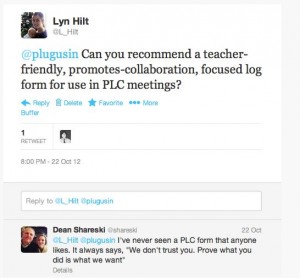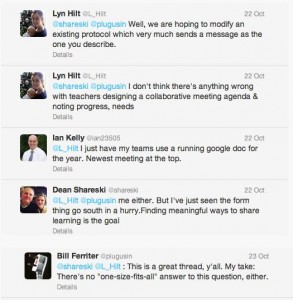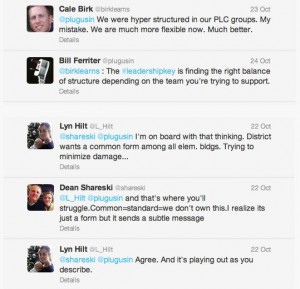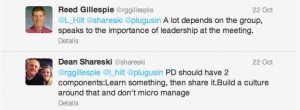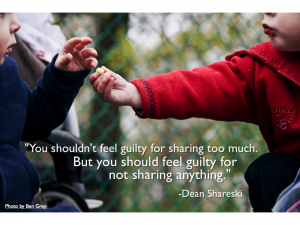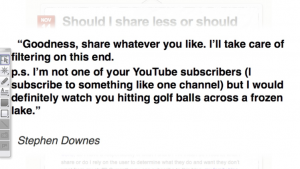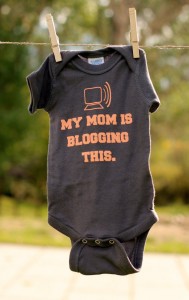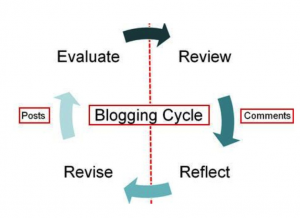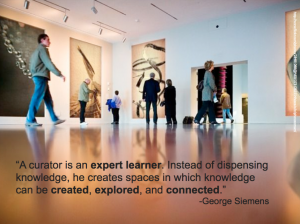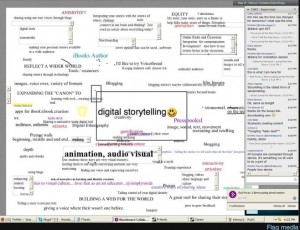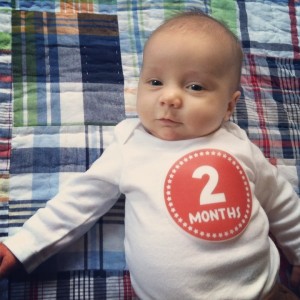I originally posted all of my #etmooc reflective posts on this Posterous site, however since the announcement of the impending demise of Posterous, I decided to share my reflections here on my main blog. Below are the posts I’ve written since the course began.
What is digital literacy?
Networking by passion.
Playing catch up here, and not a lot of time to write, so just some quick thoughts (I say that now, it will be 2,000 words until I’m done rambling) on recent (?) #etmooc webinars…
My biggest takeaway from the Networked Educational Leader session led by @gcouros was a comment made by Bernard. Sorry, Bernard, I did not catch your last name or contact info! He said,
We network by passion, not by proximity.
Yes. With the rise of social media and genuine online communities forming around passions of all kinds, there is no reason why educational leaders should limit themselves in terms of how and with whom they network. This is a topic that I examined by surveying ed leaders about the types of professional development in which they were engaged, and how beneficial those experiences were. My posts about this are here and here. My state department of ed. wasn’t thrilled that I blogged openly about my disastisfaction with our state’s principal’s development program, but thankfully they are listening to the feedback of practitioners and will be working to include more opportunities for networking in future development programs.
What do educational leaders want? To collaborate and network with other leaders. The time set aside for peer-to-peer discussions during PD sessions were reported to be the most valuable aspect of the program. However remarks also indicated there was not enough time provided for these important interactions! No educational leader wants to go at it alone. Leadership is isolating enough. We now have the tools to connect one another and our schools in powerful ways. Let’s use them!
Dave Cormier’s session, along with some discussion of PLCs in Dean Shareski‘s session, led me to consider how we’re structuring teacher learning teams in our schools and the effectiveness of those approaches. Awhile back I tweeted a request for a PLC log resource. This request sparked Dean’s attention and some others chimed in. Take a read and think about what’s being shared here:
So getting back to Dave’s session contents on Rhizomatic Learning, one of the principles he shared is, “Learning is about preparing yourself for uncertainty.” If learning is about outcomes that are already defined, then you’re not learning. Communities of practice are something we all want to exist in our schools. But can we force it? No. Can we control it? No. Because like a rhizome, this type of learning is messy, and it can go in any direction. Learners have to experience and explore for themselves. When we put a bunch of teachers in a room together, hand them an agenda that the principal or other admin. created FOR them, and say, talk about THIS during your gathering today, it is highly unlikely that true learning will occur. Do I think we need to look at student data? Yes. Do I think it needs to be the focus of every professional team meeting? No. Because where’s the learning? I wonder how many teachers leave those meetings and think, “I really learned this today, and here’s how I’m going to go back to my classroom and apply what I learned. AND, I’m PASSIONATE about what I learned at our meeting. I’m so glad we were able to explore my interests and passions in this field.”
Yeah… probably not many, especially in teams who are just starting to know, understand, and appreciate one another. (FYI, all of this applies to learning in the classroom, too. How do you know your students are learning? Are you dictating the process for them, or allowing it to run its course for each individual?)
Dave suggests these five steps to succeed in a MOOC: 1. Orient 2. Declare 3. Network 4. Cluster 5. Focus. What if we allowed our teachers to flow into natural learning teams where true collaboration can occur, rather than always group them by grade level or content area?
Can we allow our teachers to network locally by passion and trust them to make the most of their collaborative time together, because it’s what’s best for kids? I believe so. Some teams will need more nurturing than others, and that’s okay. But if we’re always mandating the learning outcomes, the learning will be marginal at best.
Sharing is caring.
Two years ago I first viewed Dean Shareski‘s work Sharing: The Moral Imperative, and it made perfect sense to me. My first year of teaching I was the only sixth grade teacher in a very small elementary school. There was no “team.” I had a mentor, but frankly, she didn’t like me very much. I was an energetic young lass, bursting with the thrill of having my own classroom and eager to engage my students in adventurous new learning opportunities! I basically threatened the status quo, and she was unamused. A few years later, our district transitioned from a junior high school to a middle school, and all sixth grade teachers and classes made the move as well. I then had the chance to work with a team of teachers every day. We met and planned together, discussed students, shared ideas, and comraderie quickly formed. I so prefered that environment to one of isolation. Who wouldn’t?
As I tuned into the archive of Dean’s #etmooc webinar, he again made it clear for me why sharing is caring when it comes to the field of education and learning. A few of Dean’s quotes and those he shared resonated with me, this being one of them:
“Sharing, and sharing online specifically, is not in addition to the work of being an educator. It is the work.” –Ewan Mcintosh
Questions Dean raised that we should ask ourselves: What, if any, are your obligations to share beyond your students? What could/should you share? With whom should you share? What are the dangers of sharing? The benefits?
There are teachers with whom I’ve worked who share freely and openly with colleagues. There are others who prefer to exist behind closed doors. How does that benefit their students? Their professional growth? I was appalled last year when one of my teachers told me a story about an experience she had during a curriculum writing session. All of her grade level’s teachers were together writing a new curriculum. A teacher from another building showed the group a resource he had designed for a unit. It was an excellent resource, so, naturally, my teacher asked for a copy so she could use it in her classroom. He refused, saying he spent too much time on it to just give it away. I seriously could not believe an educator would blantantly refuse to help a colleague in that manner.
Clearly, he did not exist in a culture of trust. As Dean stated,
“If we create cultures of trust and sharing, accountability is built in, not contrived or imposed, it just is.”
(There was next a conversation about PLCs and what true collaboration is, and I’m going to save that for a separate post because I have numerous thoughts on that issue.)
So all of this talk about sharing as my obligation causes a lot of questions/thoughts to wrestle in my brain. I don’t know why, but sites like Teachers Pay Teachers rub me the wrong way. I know why they exist – teachers don’t get paid enough, and many have to work side jobs to make ends meet, so selling their creative efforts seems like a logical idea. But there are probably thousands of educators who freely share their work because it’s the right thing to do. And because they do, I benefit. Maybe I am a hypocrite, because I’ve received compensation for presentations I’ve given to groups of educators. Shouldn’t I just volunteer my time and efforts for free in the spirit of sharing? Of course, even though I’m being compensated, I am sharing. Bill Ferriter tackled this issue in his post Should teachers be ashamed when they promote their work?
Here’s what I do know is not okay: taking the work of someone else who shared it freely and selling it for your own profit! I was sad to hear this happened to the talented Krissy Venosdale who creates gorgeous, inspirational images to share with us all. I’ve had entire blog posts copied/pasted elsewhere and published under someone else’s name, as have many other educators I know. Seriously? There are teachers/admin who think that’s an acceptable practice? What does that teach kids?
One of the other great points made in Dean’s presentation was a comment Stephen Downes made in regards to people “oversharing.” Often we are cautioned not to share “too much.” Stephen says
Exactly! I can’t expect all of the information that comes my way to be “prefiltered” for my convenience! I have to use my brain and discern what’s meaningful to me and what isn’t. We need our kids to be able to do the same.
To conclude this somewhat rambling post, I will continue to promote sharing among educators because I do believe it’s in the best interest of us all.
“None of us is as smart as all of us.”
Link to top image in my Flickr gallery
Blogging about blogging.
This morning I listened to the archived introduction to blogging webinar hosted by Sue Waters. I’m a fan of Sue and the amazing work she’s done with educational blogging, so I knew the discussions would be worthwhile, even though I suppose I’ve been “introduced” to blogging awhile ago. See The Principal’s Posts #shamelessplug
Sue began by sharing her main reason for blogging, and the reason was simple: it gave her a way to reflect. She even referred to herself as “the reluctant blogger.” I remember my undergraduate days, hearing from my professors the importance of reflecting after every lesson. They suggested (and still do, from what I understand) using sticky notes strategically placed in teachers’ manuals to note what went well and what needed improvement in order to adjust future lessons.
I’ve used this blogging cycle graphic that Sue created in many of my presentations to teachers/administrators to help support the idea of using blogs in the classroom and school. Some consider blogging a peripheral activity, an “extra,” something unnecessary in the grand scheme of leraning, but take a look at the skills Sue highlights in this process. Don’t we want our students (and teachers) to have the skills to reflect upon and revise their thinking? To be evaluative learners?
Often bloggers get hung up on what to write, myself included. I’ve gone months at a time without posting, struggling to find a topic to write about, never able to find the words. There are times when I’ve found it very challenging to express my thoughts in writing, which is crazy, because writing has always come naturally to me. If I would just let go and write, I wouldn’t encounter these issues. It’s easy for bloggers to be more concerned about their readers than about the benefits of the process. “What if no one wants to read this? What if someone thinks what I have to say is meaningless and stupid?” Well, so be it. Blog for you. One of the webinar participants expressed these concerns in the sidebar chat. She wrote that she felt intimidated and that she felt she didn’t have anything to say. When I’ve tried to approach the idea of blogging with my staff, my teachers felt the same way.
Sue responded, “Don’t worry about it. Write what you want to write for yourself.” She reminded us not to worry about writing lengthy posts as she often does. “I write what I need to write, how I need to write. You do the same,” she encouraged.
Sue offered some great advice about the use of RSS/Google Reader to help organize the #etmooc blogs, those feeds found in the blog hub so skillfully compiled by Alan Levine. I have already subscribed to this bundle in my Reader and only wish I had the time to read every post!
If you’re ready to begin reflecting in this meaningful way, but aren’t quite sure where to start, visit Sue’s Edublogs site for the Kick Start Your Blogging challenges. Be sure to peruse the many useful blogging resources she includes here to help you along the way.
Another great resource shared in the webinar was this YouTube clip featuring thoughts from Derek Shivers about voice and how our contributions, while not always obviously meaningful to others, have great potential. He states, “We’re clearly a bad judge of our own creations. We should just put it out, and let the world decide.”
My real takeaway from this session actually has more to do with reading than writing. Sue said that while many bloggers are thoughtful, diligent posters, they do not devote enough time to reading and commenting on others’ work. She suggested that before starting a blog of your own, it is beneficial to immerse yourself in reading and commenting on others’ blogs. A recent post shared by Tony Baldasaro entitled Feedback and Relationships echoed these sentiments. Tony stresses the importance of feedback in online relationships due to the lack of personal interactions in those settings. He made a plea to ensure that we’re not just superficially “liking” or retweeting someone’s blog post, photo shared, or other work without also providing feedback to the author or sharing why we found something valuable enough to share.
It is, of course, impossible to comment on every blog post you read. But as someone who has been blessed with blog readers who write feedback on my posts, I can tell you that much deeper conversations and understandings emerge when readers take the time to comment on my posts. Their ideas are so, so welcome and their feedback is meaningful. I know I need to do a better job of commenting on others’ posts, and also ensuring that I am commenting back to the fine folks who comment on my work.
Other thoughts: As an active blogger, I’m modeling for my staff, students, and school community that I am a reflective learner. I used to be terrified that a parent would stumble upon my personal blog (not the school blog) and read through my posts. And then I thought, I should want them to do that! They would learn so much about my leadership style and my work in school with their students every day! We need to model for our children the importance of reflective practice. No matter what path they choose in life, they will be expected to be a reflective practitioner in order to improve.
So, on that note, thanks for reading. Feel free to leave a comment if you’re so inclined. Off to my Reader feeds…
“You are what you share.”
When it comes to personal learning networks, the more you give, the more you receive. It’s a topic I touched upon in a blog post last year, Effort In, Reward Out. I think so many times that people dip their toes into social learning spheres, only to find there’s no immediate payback. This is frustrating, they gruff, “Twitter is useless!” and that’s the end of that. Your ultimate goal as a valued member of a PLN should be to give and share, so that others can learn from your expertise, as you do theirs.
One of the #etmooc topics during last week’s Orientation was Introduction to Social Curation. (I really appreciate that the #etmooc Blackboard sessions are being archived!) I enjoyed learning more about social bookmarking and curation. I actually didn’t pause to consider the difference between the two terms before this webinar, I just incorrectly assumed they were one in the same.
Jeff Heil (@jheil65) led the session, and he began discussing social bookmarking and its benefits. Social bookmarking is saving websites as bookmarks in a social space such as Diigo or Delicious. Typically users tag and/or list their bookmarks to help organize their resources. (I typically do a very poor job of tagging which is one area in this realm I need to improve.) Other benefits include the ability for a tool such as Diigo to become valuable in research, as you not only have access to your own bookmarks, but those of an entire community of learners. He said, “You can tap into the community of people who are bookmarking and tagging things for intrinsic reasons.” You can then share your lists and resources with others. There are tons of groups found within the services so you can subscribe to topics of interest. For example, the #etmooc group.
With content curation, you have a topic in mind, and you amass resources that support learning more about that topic. For example, I could begin curating resources to support learning more about “the use of iPads in the primary grades.” I might use a tool such as scoop.it or paper.li to save all of those resources in one place. I can then share out the curated content to share with my network. Others who are interested in the same topics I am researching could find great benefit in my curated resources. Curation is one of the things that “user-generated learners” do. I recommend Kristen Swanson’s book on this topic. I love this quote from George Siemens and use it often in my social media presentations for administrators.
Here are my thoughts/my experiences with these topics thus far:
- As an administrator, I find a lot of value in serving as a curator of resources for my teachers, students, and colleagues. I’ve used Diigo with teachers in my school and administrative colleagues, using lists to share. Some of my teachers then led the way with their grade level colleagues and started groups to share curricular resources across the district! My administrative colleagues were able to subscribe to the list and receive daily/weekly/whatever they chose updates featuring the resources I bookmarked. A few of them actually subscribed 🙂
- Some reasons I love Diigo- I love starring items in my Google Reader feed or favoriting tweets and having the item saved right to Diigo. I love being able to access my bookmarks from any device. As someone who uses a school-issued PC (blargh) at work and a Mac and other OS devices at home, this comes in handy. I know I need to get better at organizing this information so I can make better use of the resources. (Same with Pocket). As Jeff mentioned in the webinar, there are a lot of web tools and other features such as highlighting that Diigo offers.
- I also use Delicious. For a long time, when I’d favorite resources from Zite, they would be sent to Delicious. There wasn’t an option to save them to Diigo unless I went the extra step and opened the resource in Safari and used the Diigolet tool.
- I used to have a scoop.it account and used the service a few times. This morning I tried to log in but was unsuccessful, so I think in one of my attempts at streamlining my digital footprint, scoop.it didn’t make the cut. I think I still have a paper.li account, but again, don’t use it. I have to be honest- when I see the tweets “So-and-So’s paper.li Daily is Out!” I never, ever click on them, even when I’m mentioned in them. Perhaps that is something I should change. If I’m included in a curation, chances are the other resources in that space are relevant to my learning. I think those summaries would have more appeal if I knew the topic.
- I’ve used Pinterest for educational purposes, but not as often as I use it for personal inspiration. I know many educators are drawn to its visual appeal, and a lot of my teachers have expressed that they “love” Pinterest. Someone recently tweeted this 25 of the Best Pinterest Boards In Education if you’re a Pinterest user and want to check it out!
- I used Symbaloo at school to make a handy webpage of go-to resources for students and staff. I really liked the interface and it was easy to use.
- Other resources that were mentioned in the webinar- Learnist (you can request an invite), Pearltrees (tried it, hated it), and Pinboard.
- Don’t limit yourself to these types of tools. For example, you can create a blog to communicate effortlessly with your staff (goodbye, emails!) and share resources and organize through categories and/or tags. If you’re a wiki user, you can create pages devoted to specific topics and curate information in that format. Same with Google Sites. My advice? Find what works for you!
My overall takeaway is that I do a pretty decent job of sharing and social bookmarking, but my curation could use some work. I need to be more thoughtful with my efforts.
Jeff made the point to stress, “You are what you share,” and his statement made a huge impression on me. Consider your go-to people on Twitter. Why do you make sure not to miss what they tweet? Because they share. They share resources and ideas, provide feedback, and, chances are, they share a little something about themselves. Personal connections go a long way in building a strong PLN, too.
What’s in a story?
Last night was the first synchronous session for #etmooc. There were over 200 people in the room for the introductions to the concepts we’d be exploring. I’m eager to strengthen my understanding of digital storytelling and the power of “story”. At the elementary level we use a lot of digital storytelling tools, but sometimes I think we’re simply substituting a digital format for an activity that students would normally complete on paper. Where’s the extension? Enhancement? Are students driving the creative process or are teachers? One tool that I have fallen in love with is Storybird. I have seen students truly own the story when given the opportunity to freely create with this tool. The beautiful artwork ignites the imagination and helps even the most reluctant writers share their ideas. I even created my own story to share with my students and staff at last year’s opening assembly.
Someone screen captured this image from last night’s session, showing participants’ views on what digital storytelling is/what it means to them. Check out the variety in the responses! One of the perks of participating in a social learning space such as this is the varying perspectives that are shared. Looking forward to learning more in the coming weeks!
Orientation
Last year I tried to participate in a MOOC run by George Siemens, Dave Cormier, and Stephen Downes, and failed miserably. I didn’t do the work, and I didn’t make the time.
This time around I’m hoping to engage more often with the #etmooc community and content. I won’t pretend to think that I’m going to attend every session or delve into every content segment, but, a girl can dream.
About me: I’m an elementary school principal, this is my fifth year in that role, although currently I’m home spending time with my son who was born in November. I’m also our district’s elementary technology integrator, which is more of an informal role because I have to find the time to incorporate those leadership tasks amongst my principal’s workload, which is tough. I’m from a town about an hour outside of Philadelphia, Pennsylvania. I’ve been a “connected educator,” let’s call it, for the past three years or so. I’m active on Twitter @l_hilt and I blog here. I’ve formed a pretty professional solid network through my participation in online spaces, and I’m also happy to say I’ve formed a lot of wonderful friendships as well.
I’m going to forgo the video introduction because as the mother of a 2-month old, there isn’t enough video editing on Earth to make these bags under my eyes disappear. But here’s my little man, you can ooh and aah at his cuteness.
Most of the #etmooc topics caught my interest, and I’m hoping to learn more about the open movement and digital storytelling. We do a lot of work with digital storytelling in the elementary grades, but it’s pretty surface level.

